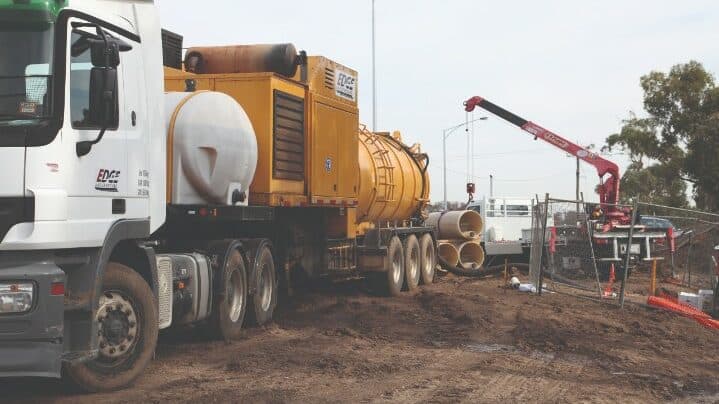Vacuum excavation is a key method to help contractors maintain a safe, environmentally friendly, and compact microtunnelling site. This method reduces worksite size by sending excavated material straight from the pit to the tank, leaving the pit clear and the site clean, and eliminating the need for multiple trucks or loaders.
Vacuum excavation in microtunnelling has many benefits – from safety, to environmental, to keeping a work site compact.
This method sends excavated spoil straight to the tank, with the displaced spoil vacuumed out through a hollow section in the drill head and subsequent drill casing, transporting it to a vacuum tank where it is securely sealed.
Keeping the worksite compact and clean
The majority of microtunnelling projects are undertaken in urban and congested areas, which means that, ideally, the worksite should be kept compact so that the surrounding environment experiences as little disruption as possible.
Microtunnelling machines such as the AXIS laser guided boring system, as operated and designed by Edge Underground, uses vacuum excavation.
Managing Director at Edge Underground, Stuart Harrison, said that this method is ideal for keeping the worksite clean.
“By using the vacuum excavation method, contractors can reduce the size of the worksite as the excavated material is sent straight from the pit to the tank, so there are no piles of spoil sitting around the site that require multiple trucks and loaders to remove,” Mr Harrison said.
“These vehicles can take up a lot of room, so eliminating the need to have them at the site clears up a lot of space and reduces disruption to the community.”
Meeting deadlines with ease
Vacuum excavation also saves the project time and money, by eliminating the need to stop and start during the project.
“There is also a cost-saving benefit of using the vacuum excavation method, as it is able to remove the spoil as it is produced, removing the need to suspend drilling operations so it can be done manually,” Mr Harrison said.
“This reduces project costs and helps ensure the pipeline is completed on time.”
Reduced environmental impact
Another benefit of vacuum excavation is that it can help contractors adhere to environmental guidelines, especially those that specify that no spoil is to be spilled onto soil or land by accident.
This is because the tank is secure, so during and after the project there is no way the spoil can spill.
“The AXIS vacuum tank is secure and sealed, so the spoil can be transported to the disposal site without worry of a spillage occurring,” Mr Harrison said.
“Risks are further reduced as microtunnelling has minimal incoming and outgoing materials, so there is less spoil to deal with and less backfilling required.
“Efficient spoil management is vital to keep a project on time and on budget, so selecting a contractor with equipment such as the AXIS laser guided boring system that can help reduce the risks associated with spoil and improve productivity at the worksite is key to achieving this.”
This system also reduces minimal emissions, which is a rising concern for all worksites.
“The AXIS is the only microtunnelling machine on the market that has been proven to have low carbon emissions,” Mr Harrison said.
“During a project in the US that used the AXIS laser guided boring system, Dr Sam Ariaratnam and his team from Arizona State University undertook an emissions study using the ‘E Calc’ emissions calculator.
“The study compared the results to alternative methods, and the AXIS system conclusively had the least emissions of all of them.”
Key safety benefits
One of the biggest risks involved with undertaking a microtunnelling project, is the possibility of cave-ins when workers are in the pit, with the risk increasing as the pit gets deeper.
Vacuum excavation lessens these concerns because it eliminates the need for on-site workers to manually handle spoil within the launch pit, which also reduces manual labour as a whole.
This is why vacuum excavation, and machines that perform it, such as the AXIS laser guided boring system, have multiple benefits for all personnel on-site; reducing safety concerns and keeping labour hours low, all whilst reducing the overall environmental impact.

